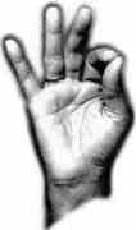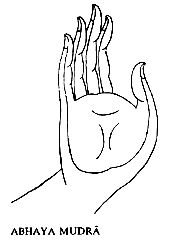Mudras
What is Mudra in Yoga?
Mudras are gestures which practice in certain period of time that helps in healing and obtaining spiritual powers for your inner.
Top 17 Mudras List in Yoga
Gyan Mudra
Apan Vayu Mudra
Pran Mudra
Surabhi Mudra
Apan Mudra
Linga Mudra
Shunya Mudra
Varuna Mudra
Dhyana Mudra
Dharmacakra Mudra
Varada Mudra
Tarjani Mudra
Abhaya Mudra
Vitaka Mudra
Bhutadamara Mudra
Namaskara Mudra
Buddha Shramana Mudra

Gyan Mudra
The thumb and the index finger are brought together in gentle contact, not pressing hard, while all other fingers are kept upright. This is the mudra most people are familiar with.
Great thinkers such as Buddha, Mahavir, Christ and Guru Nanak are generally depicted in this pose. Its practice ensures mental peace, concentration, sharp memory and spiritual feelings.
It cures insomnia and mental disorders, and dissipates tension, depression and drowsiness. This is a must for those who aspire to develop telepathy or wish to acquire extrasensory abilities.

Apan Vayu Mudra
(Also known as Mritsanjeevini Mudra)
Fold the forefinger down and touch the mound of the thumb. The little finger should be held erect.
It regulates complications of the heart. In a severe heart attack, if administered as a first aid measure within the first two seconds, it provides instant relief.

Pran Mudra
Touch the points of the little finger and the ring finger to the tip of the thumb lightly.
This is a life-giving mudra, it energizes the body and improves its vitality.
It helps to improve eyesight. A must for those who feel nervous, tired and weak.

Surabhi Mudra
Join the little finger of one hand with the ring finger of the other and vice versa. Similarly, join the forefinger with the middle finger of the other hand and vice versa. Leave the thumbs free.
This controls rheumatic inflammation and sharpens your intellect.

Apan Mudra
Join the middle finger and the ring finger with the tip of the thumb; the forefinger and the little finger should be held upright.
Provides relief in urinary problems and eases difficulty in labor and delivery. It facilitates the discharge of waste matter from the body and purifies the system.

Linga Mudra
Join both the palms and lock the facing fingers together, keeping one thumb upright. The upright thumb must be encircled by the other thumb and the index finger.
Makes the body resistant to colds, coughs and chest infections by generating heat in the body, and destroying accumulated phlegm in the chest.
It helps in weight reduction too, but has to be practiced with restraint.
Hand Mudras – Symbols of Deeper Meaning
The symbolic gestures of the hands of Buddha images, called mudras,
The intake of at least eight glasses of water, and butter and ghee (clarified butter) as cooling agents in sufficient quantities is a must.
Due to the heat it generates, it may not be possible to practice this mudra with as much ease and flexibility as the other mudras. It might prove taxing and result in a feeling of lethargy.

Shunya Mudra
Bring the middle finger down to touch the palm and bring the padding of the thumb on top of it, keeping the other fingers straight up.
Do this for 40 minutes a day.
This mudra is ideal for ailments of the ear, and also helps those of the nose and the throat.
Even five minutes of this mudra will help an earache.

Varuna Mudra
A bit like the Gyan Mudra.
Touch the tip of the little finger with the tip of the thumb while the other fingers are kept upright.
Regular practice ensures an optimum level of water in the body and heals all ailments connected with dehydration.

Varada Mudra
The Gift bestowing Gesture of Compassion (Varada Mudra) the right hand pendant with the palm turned outwards.

Dhyana Mudra
The Gesture of Meditation (Dhyana Mudra) with both hands resting on the lap, palms upwards.

Dharmacakra Mudra
The Gesture of Teaching (Dharmacakra Mudra) with both hands in front of the breast, tips of the index finger and the thumps touching.

Vitaka Mudra
The Gesture of Debate explaining the Buddha’s teachings (Vitaka Mudra) with the hands raised and the tips of the forefingers and the thumbs touch each other.

Tarjani Mudra
The Gesture Warding off Evil (Tarjani Mudra) with forefinger and little finger outstretched.

Bhutadamara Mudra
The Gesture of Warding off Evil (Bhutadamara Mudra) this is a protection gesture.

Abhaya Mudra
The Gesture of Fearlessness (Abhaya Mudra) the right hand slightly elevated, the palm turned outwards, also called the Gesture of Renunciation.

Buddha Shramana Mudra
The Gesture Beyond Misery (Buddha Shramana Mudra) also called an ascetic’s Gesture of Renunciation.

Namaskara Mudra
The Gesture of Prayer (Namaskara Mudra) with the palms folded together.

